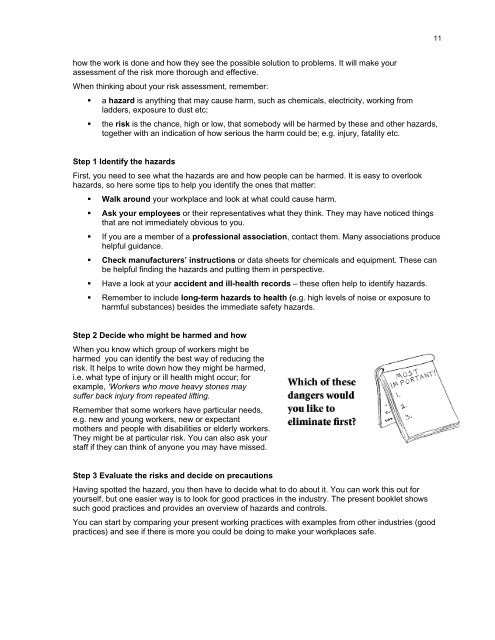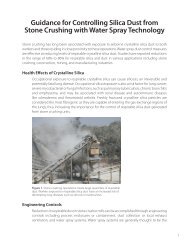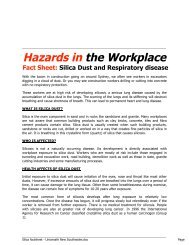Safety & Health in the Stone Crushing Industry - Occupational ...
Safety & Health in the Stone Crushing Industry - Occupational ...
Safety & Health in the Stone Crushing Industry - Occupational ...
You also want an ePaper? Increase the reach of your titles
YUMPU automatically turns print PDFs into web optimized ePapers that Google loves.
11<br />
how <strong>the</strong> work is done and how <strong>the</strong>y see <strong>the</strong> possible solution to problems. It will make your<br />
assessment of <strong>the</strong> risk more thorough and effective.<br />
When th<strong>in</strong>k<strong>in</strong>g about your risk assessment, remember:<br />
• a hazard is anyth<strong>in</strong>g that may cause harm, such as chemicals, electricity, work<strong>in</strong>g from<br />
ladders, exposure to dust etc;<br />
• <strong>the</strong> risk is <strong>the</strong> chance, high or low, that somebody will be harmed by <strong>the</strong>se and o<strong>the</strong>r hazards,<br />
toge<strong>the</strong>r with an <strong>in</strong>dication of how serious <strong>the</strong> harm could be; e.g. <strong>in</strong>jury, fatality etc.<br />
Step 1 Identify <strong>the</strong> hazards<br />
First, you need to see what <strong>the</strong> hazards are and how people can be harmed. It is easy to overlook<br />
hazards, so here some tips to help you identify <strong>the</strong> ones that matter:<br />
• Walk around your workplace and look at what could cause harm.<br />
• Ask your employees or <strong>the</strong>ir representatives what <strong>the</strong>y th<strong>in</strong>k. They may have noticed th<strong>in</strong>gs<br />
that are not immediately obvious to you.<br />
• If you are a member of a professional association, contact <strong>the</strong>m. Many associations produce<br />
helpful guidance.<br />
• Check manufacturers’ <strong>in</strong>structions or data sheets for chemicals and equipment. These can<br />
be helpful f<strong>in</strong>d<strong>in</strong>g <strong>the</strong> hazards and putt<strong>in</strong>g <strong>the</strong>m <strong>in</strong> perspective.<br />
• Have a look at your accident and ill-health records – <strong>the</strong>se often help to identify hazards.<br />
• Remember to <strong>in</strong>clude long-term hazards to health (e.g. high levels of noise or exposure to<br />
harmful substances) besides <strong>the</strong> immediate safety hazards.<br />
Step 2 Decide who might be harmed and how<br />
When you know which group of workers might be<br />
harmed you can identify <strong>the</strong> best way of reduc<strong>in</strong>g <strong>the</strong><br />
risk. It helps to write down how <strong>the</strong>y might be harmed,<br />
i.e. what type of <strong>in</strong>jury or ill health might occur; for<br />
example, ‘Workers who move heavy stones may<br />
suffer back <strong>in</strong>jury from repeated lift<strong>in</strong>g.<br />
Remember that some workers have particular needs,<br />
e.g. new and young workers, new or expectant<br />
mo<strong>the</strong>rs and people with disabilities or elderly workers.<br />
They might be at particular risk. You can also ask your<br />
staff if <strong>the</strong>y can th<strong>in</strong>k of anyone you may have missed.<br />
Step 3 Evaluate <strong>the</strong> risks and decide on precautions<br />
Hav<strong>in</strong>g spotted <strong>the</strong> hazard, you <strong>the</strong>n have to decide what to do about it. You can work this out for<br />
yourself, but one easier way is to look for good practices <strong>in</strong> <strong>the</strong> <strong>in</strong>dustry. The present booklet shows<br />
such good practices and provides an overview of hazards and controls.<br />
You can start by compar<strong>in</strong>g your present work<strong>in</strong>g practices with examples from o<strong>the</strong>r <strong>in</strong>dustries (good<br />
practices) and see if <strong>the</strong>re is more you could be do<strong>in</strong>g to make your workplaces safe.







